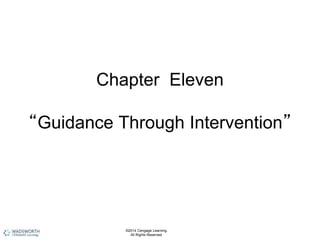
Chapter 11 Guidance through Intervention
- 1. Chapter Eleven “Guidance Through Intervention” ©2014 Cengage Learning. All Rights Reserved.
- 2. Guiding Questions: 1. What considerations are important for when boys have conflicts? 2. What conditions make intervention necessary? 3. What are four methods of crisis management? ©2014 Cengage Learning. All Rights Reserved.
- 3. Guiding Questions: 4. What are comprehensive guidance strategies for working with Level Three strong needs mistaken behavior? 5. What techniques assist the teacher to manage personal feelings of anger? 6. Cultural Responsiveness/Family Partnerships: What helps when teachers and parents disagree? ©2014 Cengage Learning. All Rights Reserved.
- 4. After studying this chapter, you should be able to: • Describe comprehensive guidance strategies for working with Level Three strong needs mistaken behavior. • Identify techniques that assist the teacher to manage personal feelings of anger. • Discuss considerations when teachers and parents disagree. ©2014 Cengage Learning. All Rights Reserved.
- 5. Special Considerations for Boy’s Conflicts • 80 out of 100 preschoolers who are expelled are boys, calling attention to the importance of how teachers handle conflicts involving boys. • A culture gap has emerged between structured academic settings and the behavior patterns and learning styles of boys. This gap has continued as more girls have finished school and grown up to become teachers. ©2014 Cengage Learning. All Rights Reserved.
- 6. Special Considerations for Boy’s Conflicts • Boy-friendly classrooms need to be developmentally appropriate and take into account a variety of intervention considerations: – Be responsive to boys while being authoritative instead of authoritarian – Diffuse the situation if emotions haven’t yet exploded – Talk in a private manner – Avoid threats that could easily escalate into a power struggle – Follow through on what you say you will do – Talk with boys about their emotions – Teach boys to manage their impulses – Nurture boys by fostering emotional connectiveness ©2014 Cengage Learning. All Rights Reserved.
- 7. Need for Intervention • When deciding on whether or not to intervene in a situation, look to your established guidelines, the specific child and situation, and self-monitor your own mood. • A majority of teachers would intervene if: – Children cannot resolve a situation themselves, and the situation is deteriorating – One or more children cause serious disruption to the education process – The danger of harm exists • In serious mistaken behavior, two or all three of these conditions are present and all teachers should then intervene. ©2014 Cengage Learning. All Rights Reserved.
- 8. Crisis Management • Four crisis management techniques are: – Being direct (describing-expressing-directing) – Commanding a choice (including redirection) – Calming everyone involved (sometimes by separation) – Using physical restraint (the passive bear hug) ©2014 Cengage Learning. All Rights Reserved.
- 9. Addressing Strong Needs Behaviors • Children who show chronic Level Three mistaken behavior are making a request for help. • An appropriate response to this request is to take a comprehensive guidance approach: – 1. Work to develop relationships with families when the child first begins, before conflicts start. – 2. Use crisis management techniques to prevent harm to the child and others. – 3. Learn more about the child at home and at school. ©2014 Cengage Learning. All Rights Reserved.
- 10. Addressing Strong Needs Behaviors (continued) • An appropriate response to this request is to take a comprehensive guidance approach: – 4. Implement what you have learned in programming for the child – 5. Improve the quality of the teacher-child relationship. – 6. Hold an individual guidance plan (IGP) meeting and develop a written IGP if necessary. – 7. Utilize specific support, prevention, and intervention techniques designed for the child. – 8. Review and modify the IGP if necessary. ©2014 Cengage Learning. All Rights Reserved.
- 11. Managing Personal Feelings of Anger • Because teachers are human and cannot always accomplish what they want, they feel anger. • Three personal safeguards for teachers include: – 1. Monitor feelings and make adjustments as needed. • Use low-stress back-up activities • Ask another adult to take the lead – 2. Express anger carefully. • Allow cool-down time • Direct comments to the situation, not the child – 3. Practice reconciliation. • Forgive yourself • Own up to mistakes ©2014 Cengage Learning. All Rights Reserved.
- 12. Family Partnerships • To reduce tension when teachers and parents disagree, teachers should: – Encourage mutual respect – Model reflective listening – Talk to situations, not the child – Invite continued involvement – Communicate with staff and other consulting professionals – Switch to mediation, as needed – Collaborate with colleagues for safety ©2014 Cengage Learning. All Rights Reserved.
